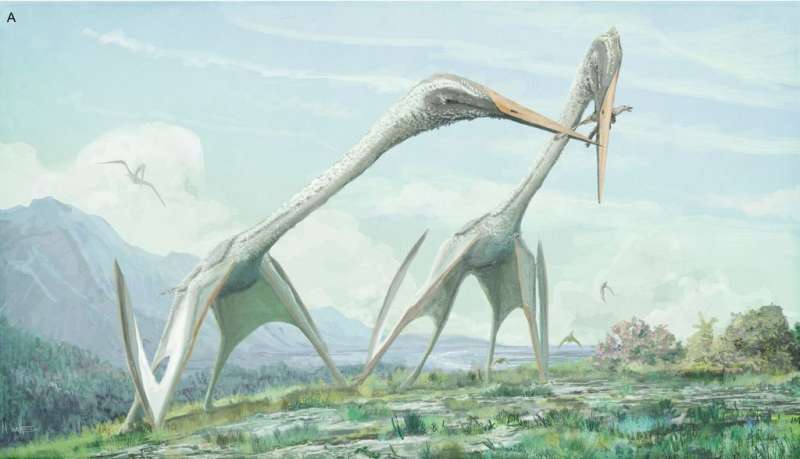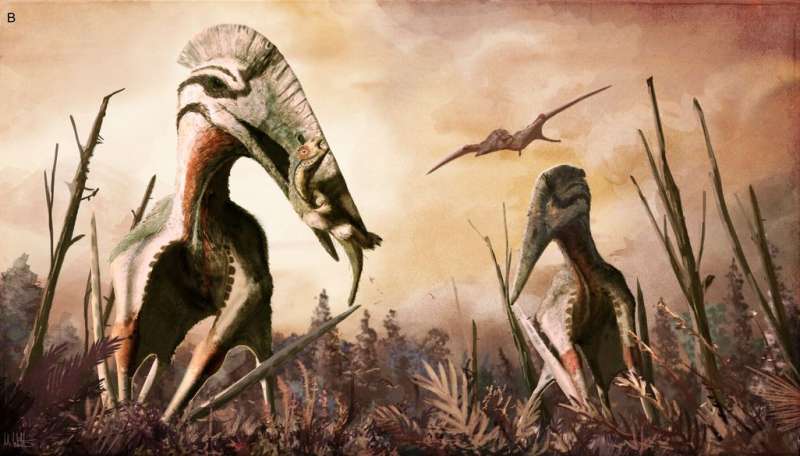January 27, 2017 report
Fossils of giant pterosaurs found in Transylvania

(Phys.org)—A pair of researchers in the U.K. has identified fossils found in the Transylvania area in Romania as those of a pterosaur they have named Hatzegopteryx—a giant, muscle-bound flying reptile that could eat prey as large as a small horse. In their paper published in the journal Peer, Mark Witton with Portsmouth University and Darren Naish, with the University of Southampton describe the fossils and what they believe the creature looked like when it was alive.
Fossil remains of pterosaur types have been found at many sites around the world—they usually had long necks and legs and were capable of eating prey as big as a modern rat. They have also been known to vary quite dramatically in size, from that of a jet fighter to a simple modern sparrow. Hatzegopteryx is quite different, though, the researchers point out, having a short, thick neck with extremely wide bones and a spongy filling which added even more strength. It also had a much wider mouth than others in the pterosaur family, allowing it to take down and swallow much larger prey. The fossils found thus far suggest that the creature was likely stocky in general with strong wing, and back and leg muscles possibly weighing as much as a quarter-ton.
The fossils were dated to the late Cretaceous (approximately 70 million years ago) and were found in a part of Romania that scientists believe was once part of Hateg Island in the Tethys Sea. Prior digging in the area has turned up fossils of dwarf dinosaurs and a type of ancient, long-necked horse—but no big teeth suggesting anything larger. That suggests that Hatzegopteryx was likely the dominant predator on the island, able to swoop down and grab young dinosaurs or horse-sized prey at will without fear of being attacked by something bigger or stronger.

Scientists have not yet agreed on the evolutionary history of the pterosaur—many believe that they are related to modern crocodiles and ancient dinosaurs, and should therefore belong to the group archosaurs, but that cannot happen until more evidence is found, leading to a consensus.
More information: Darren Naish et al. Neck biomechanics indicate that giant Transylvanian azhdarchid pterosaurs were short-necked arch predators, PeerJ (2017). DOI: 10.7717/peerj.2908
Abstract
Azhdarchid pterosaurs include the largest animals to ever take to the skies with some species exceeding 10 metres in wingspan and 220 kg in mass. Associated skeletons show that azhdarchids were long-necked, long-jawed predators that combined a wing planform suited for soaring with limb adaptations indicative of quadrupedal terrestrial foraging. The postcranial proportions of the group have been regarded as uniform overall, irrespective of their overall size, notwithstanding suggestions that minor variation may have been present. Here, we discuss a recently discovered giant azhdarchid neck vertebra referable to Hatzegopteryx from the Maastrichtian Sebeş Formation of the Transylvanian Basin, Romania, which shows how some azhdarchids departed markedly from conventional views on their proportions. This vertebra, which we consider a cervical VII, is 240 mm long as preserved and almost as wide. Among azhdarchid cervicals, it is remarkable for the thickness of its cortex (4–6 mm along its ventral wall) and robust proportions. By comparing its dimensions to other giant azhdarchid cervicals and to the more completely known necks of smaller taxa, we argue that Hatzegopteryx had a proportionally short, stocky neck highly resistant to torsion and compression. This specimen is one of several hinting at greater disparity within Azhdarchidae than previously considered, but is the first to demonstrate such proportional differences within giant taxa. On the assumption that other aspects of Hatzegopteryx functional anatomy were similar to those of other azhdarchids, and with reference to the absence of large terrestrial predators in the Maastrichtian of Transylvania, we suggest that this pterosaur played a dominant predatory role among the unusual palaeofauna of ancient Haţeg.
Journal information: PeerJ
© 2017 Phys.org




















